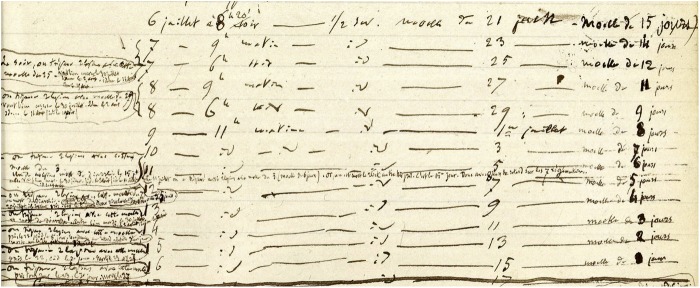The first human vaccination with a rabies virus attenuated by exposure to dry air started on July 6, 1885, and was reported in the session of the French Academy of Sciences on October 26, 1885 (1).
In his report, Louis Pasteur describes how experiments started in 1882 led him to a rapid prophylactic method that had been successful many times in dogs. Pasteur was confident that it could be generally applied to all animals and also to man.

Image of Pasteur’s handwritten table of the rabies vaccination procedure. English translation version of the table is below. See Fig. S1 for complete image of page. Image courtesy of Bibliothèque nationale de France.
Table 1.
| Half a syringe |
|||
| Marrow exposed to dry air on: | Marrow dehydration for: | ||
| 6 July | 8 pm | 21 June | 15 d* |
| 7 July | 9 am | 23 June | 14 d* |
| 7 July | 6 pm | 25 June | 12 d* |
| 8 July | 9 am | 27 June | 11 d* |
| 8 July | 6 pm | 29 June | 9 d* |
| 9 July | 11 am | 1 July | 8 d* |
| 10 July | 11 am | 3 July | 7 d* |
| 11 July | 11 am | 5 July | 6 d** |
| 12 July | 11 am | 7 July | 5 d** |
| 13 July | 11 am | 9 July | 4 d** |
| 14 July | 11 am | 11 July | 3 d** |
| 15 July | 11 am | 13 July | 2 d** |
| 16 July | 11 am | 15 July | 1 d** |
Nonvirulent in rabbits.
Virulent in rabbits.
The method involved developing a consistent source of virulent virus by taking pieces of spinal cord from a rabid street dog and inoculating by trepanation under the dura mater (dura) into the cranium of a rabbit, and then passing it from rabbit to rabbit 20–25 times until the virus was consistently virulent. When Pasteur had established a way to obtain rabbits with spinal cord material that was consistently virulent, he took pieces of the spinal cord, each a few centimeters long, and exposed them to dry air. The exposure to dry air (ensured by fragments of potassium in the bottom of the container) gradually decreased the virulence until it totally disappeared.
Pasteur had inoculated approximately 50 dogs with a suspension of the dehydrated spinal cord and he had observed that the dogs had become refractory to the inoculation with virulent rabid spinal material, when on Monday, July 6, 1885, three people arrived from Alsace. One of them was Joseph Meister, a nine-year-old boy who had been bitten by a dog at 8:00 AM on July 4. The boy had at least 14 bites and his death from rabies seemed inevitable.
Using the experience he had already with the 50 dogs, on the evening of July 6, together with Dr. Vulpian and Dr. Grancher (professor at the Faculty of Medicine, University of Paris), Pasteur inoculated the boy with material from a rabid rabbit spinal cord that had been dehydrated for 15 days (since June 21), as indicated in the handwritten table (shown in the image and transcribed into English below).
From July 7 to July 16, Pasteur continued to inoculate Meister with rabid rabbits’ spinal cord material that had been air dried for increasingly shorter periods (15, 14, 12, 11, 9, 8, 7, 6, 5, 4, 3, 2, 1 day). The entire immunization procedure is reported in Pasteur’s handwritten table.
In parallel, Pasteur had inoculated rabbits with the same material used for Joseph Meister and had found that the spinal material used on July 6, 7, 8, 9, and 10 was not virulent, but the others were increasingly virulent and, therefore with the inoculations of July 15 and 16, he had exposed Meister to fully virulent virus. Pasteur concluded that the boy had not only survived the rabies from the bites of a rabid dog, but also direct inoculation of a more virulent virus.
Supplementary Material
Footnotes
The author declares no conflict of interest.
This article contains supporting information online at www.pnas.org/lookup/suppl/doi:10.1073/pnas.1414226111/-/DCSupplemental.
References
- 1.Pasteur L. 1885. Méthode pour prévenir la rage après morsure. Comptes Rendus des Séances de l’Académie des Sciences. Séance du lundi 26 octobre 1885.
Associated Data
This section collects any data citations, data availability statements, or supplementary materials included in this article.


